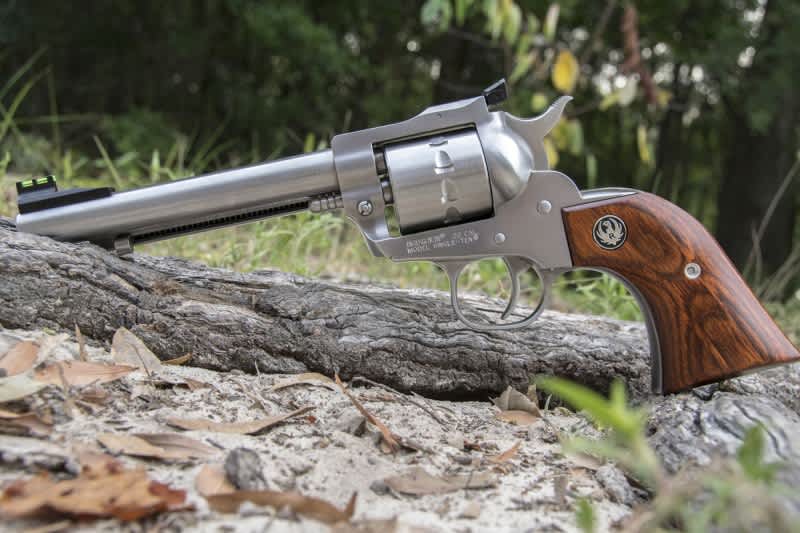Ruger Single-Ten Revolver
Jim Grant 08.20.15

Single-action rimfire revolvers are one of those things whose allure, while undeniable, is hard to quantify. They’re not as fast or easy to reload as a semiauto and often hold less ammunition and cost more than their autoloading alternatives. While they do offer some real improvements over semiautos, the biggest reasons to purchase one are intangible—which is why I have such a difficult time explaining my seemingly irrational love for the .22 LR Ruger Single-Ten.
I say irrational, but that’s not wholly accurate. Like seeing a ballgame at Fenway Park or Yankee Stadium, the experience is more than the sum of its components. It’s not dissimilar from firing a bolt-action rifle, or lever-action carbine—a single-action revolver allows shooters to fully understand and experience what is happening under the hood. This creates a stronger connection than simply slamming a magazine in, charging the firearm and launching rounds downrange.

Sound kind of hokey?
You bet, but it’s something irrefutable to those who’ve experienced it firsthand. Interestingly enough, shooting the Single-Ten is enjoyable and nostalgic in very different ways depending on the shooter using it.
Shooters who grew up with spaghetti westerns will conjure very different memories than younger shooters more accustomed to firearms of the a more tactical fare. Personally, movies like Young Guns and 3:10 to Yuma come to mind when I’m blasting unsuspecting soda cans at 25 yards with the little Ruger.
That said, the Ruger Single-Ten brings a lot more to the table than simply good feelings and nostalgia. Equipped with a five-and-a-half-inch barrel topped with adjustable Williams fiber optic sights, the Single-Ten may be old fashioned, but it’s far from outdated. This fact is especially apparent with its namesake, 10-round cylinder. Ten rounds of ammo doesn’t sound impressive to shooters accustomed to double-stack, magazine-fed pistols, but is at the top of what the small-framed revolver can accommodate.

Which is good, because the cylinder on the Single-Ten is fixed, making the reloading process more involved than most. Reloading the pistol entails opening the loading gate and then aligning it with the spent charging holes of the cylinder before manually extracting spent casings with the ejector rod. It’s not exactly high speed, low-drag.
Which is perfect, because the Ruger isn’t designed for that. The Ruger is more of a lazy Sunday plinking pistol than a quick-shooting polymer blaster. This deceleration by design forces shooters to take their time when using the pistol. Consequently, this helps them truly appreciate the wheelgun’s potential for accuracy.
Like I said, this is partially due to the fact the pistol is single-action-only—the hammer must be manually retracted or “cocked” between every shot fired. In theory this is tedious, but in practice it’s oddly satisfying. Like hearing the protagonist in a bad western get the drop on a ne’er-do-well while slowly cocking the hammer on his Colt Single Action Army.

Additionally, the Ruger’s 5.5-inch barrel offers shooters an incredibly lengthy sight radius for a handgun. In effect this makes the sights more precise, as finer adjustments and alignment are possible, thus narrowing the margin of human error.
In testing, the Ruger Single-Ten made short work of anything squirrel-sized out to 35 yards when fired unsupported. It also tended to group better with standard-velocity ammo than high-velocity varieties. In either case, the pistol achieved groupings ranging from 2.2 to 3.1 inches at 25 yards. This was done with the iron sights and with the pistol rested on a sandbag.
After some consideration on the matter, I’m convinced that the Ruger is ideal for first-time shooters and grandparents looking to teach adolescent shooters how to handle a handgun. The slow, deliberate nature of both shooting and loading the Single-Ten helps ensure safe operation by less experienced pistoleros.
This isn’t to say the six-gun is only suitable for green shooters, in fact I found the little 10-shooter finding its way into my range bag more often than any other firearm I own. There’s just something cathartic about taking your time, lining up irons, and successfully plinking miniscule targets with a single-action revolver.
That said, with a $659 MSRP, the Single-Ten isn’t cheap, but if my short time is any indication, shooters are getting exactly what they pay for: a high-quality, nigh-indestructible, classically-styled revolver that will outlast them and their grandchildren. It may not be as tactical as other popular rimfire guns, but it fills its role perfectly. Shooters looking for a nostalgic plinker, quality wheelgun, or simply an excuse to show off their terrible John Wayne impression ought to take a closer look at Ruger’s Single-Ten.

